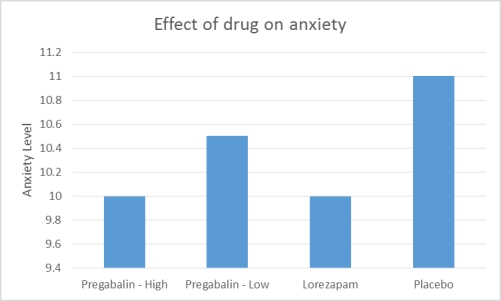Multiple Choice
Use the following to answer questions
Scenario I
Scenario I is based on fabricated data inspired by the following study:
Pande, A. C., Crockatt, J. C., Feltner, D. E., et al. (2003) . Pregabalin in generalized anxiety disorder: a placebo-controlled trial. The American Journal of Psychiatry, 160(3) , 533-540.
Effect of Pregabalin on Anxiety
Pande and colleagues examined whether pregabalin (brand name Lyrica) was as effective as lorazepam (brand name Ativan) in treating anxiety. To that end, they administered either a low dose of pregabalin, a high dose of pregabalin, lorazepam, or placebo to participants for four weeks, then measured the participants' anxiety using the Hamilton Anxiety Rating Scale. The researchers found that not only did the high dose of pregabalin significantly reduce anxiety, but that it also reduced anxiety as well as lorazepam. The results of the study (Figure 1) indicate that pregabalin may be an effective alternative to lorazepam to treat anxiety in adults.
 Figure 1. Hypothetical results of Pande et al (2003) showing the impact of each treatment on anxiety level. Anxiety was measured using the Hamilton Anxiety Rating Scale.
Figure 1. Hypothetical results of Pande et al (2003) showing the impact of each treatment on anxiety level. Anxiety was measured using the Hamilton Anxiety Rating Scale.
-(Scenario I) Patty was a participant in the study described in Scenario I. She told her friend she volunteered because she suffers from social anxiety and thought her participation might help her. Patty appears to be motivated based on:
A) altruism.
B) utilitarianism.
C) egoism.
D) idealism.
Correct Answer:

Verified
Correct Answer:
Verified
Q24: What does IRB stand for?<br>A) Institutional Review
Q38: Researchers must complete an IRB proposal:<br>A) every
Q83: Which is the hardest to guarantee?<br>A) confidentiality<br>B)
Q88: Which is the correct order of classification
Q90: Vito is preparing to conduct his first
Q91: Compare and contrast the Institutional Review Board
Q92: Jessa is a health psychologist who is
Q98: Dr. John Watson's research with the baby
Q129: IRB classifications include all of the following,
Q151: The belief that ethical decisions should be